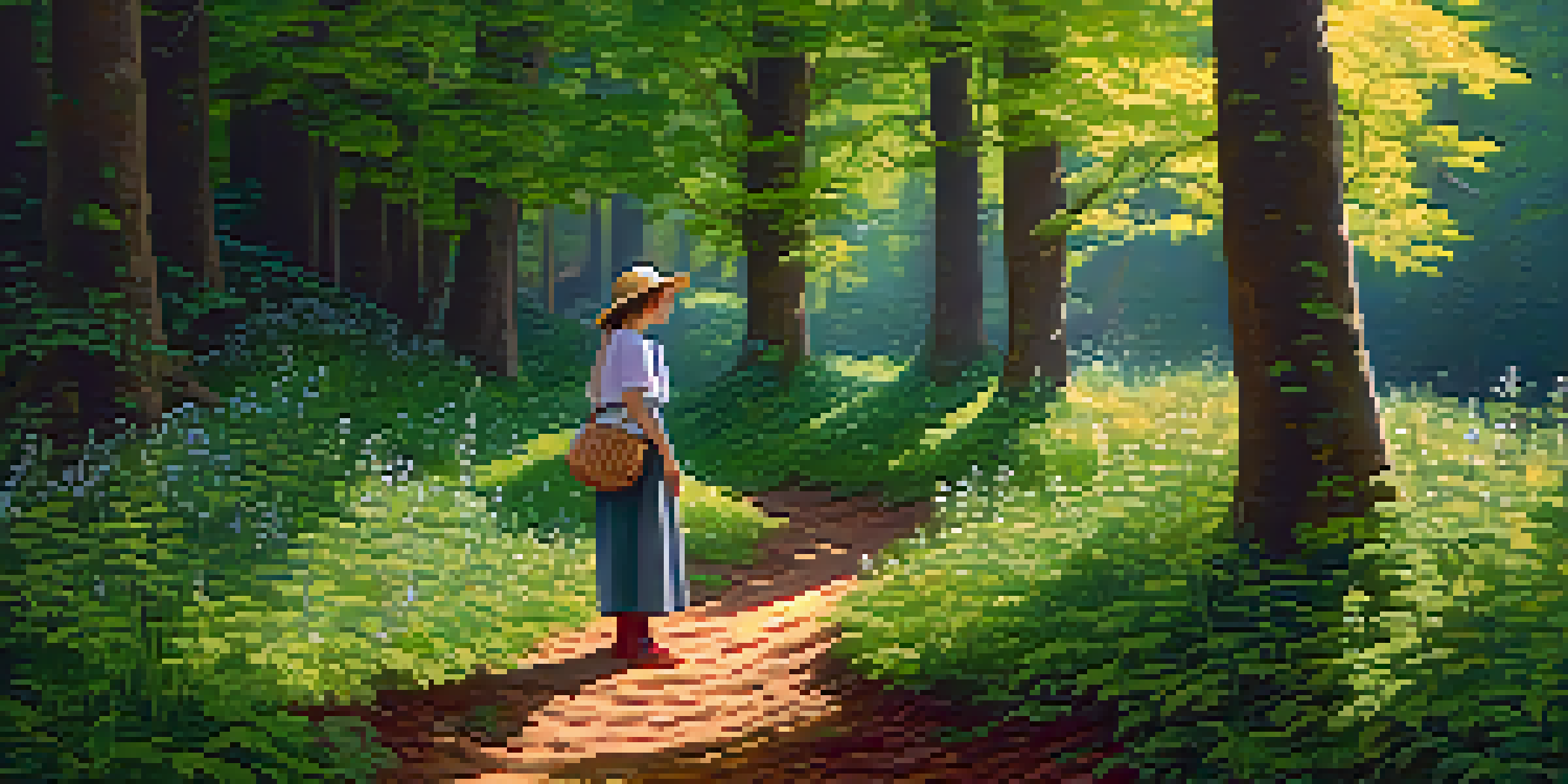Foraging for Medicinal Plants: Benefits and Best Practices

Understanding the Basics of Foraging for Medicinal Plants
Foraging for medicinal plants is the practice of gathering wild plants known for their healing properties. This ancient skill connects us to nature and offers an alternative to conventional medicine. By understanding which plants are safe and beneficial, you can tap into a wealth of natural remedies right in your backyard.
In every walk with nature one receives far more than he seeks.
Before diving into foraging, it's essential to educate yourself about local flora. Not all plants are safe to consume, and some may even be toxic. Resources such as field guides, online forums, and local workshops can help you learn to identify beneficial plants and distinguish them from harmful ones.
Additionally, foraging fosters a deeper relationship with the environment. You become more aware of your surroundings and the natural cycles of life, which can enhance your overall well-being. It's not just about collecting plants; it's about building a connection with nature.
The Health Benefits of Foraging for Medicinal Plants
Foraging for medicinal plants can offer numerous health benefits. Many wild plants are rich in vitamins, minerals, and antioxidants, which can boost your immune system and support overall health. For instance, dandelion leaves are packed with nutrients and have been used traditionally to help with digestion and detoxification.

Moreover, incorporating foraged plants into your diet can lead to a more diverse and nutrient-rich food source. Unlike store-bought herbs, wild plants often retain higher levels of nutrients due to their natural growth conditions. This variety can help you maintain a balanced diet and improve your health.
Foraging Connects You to Nature
Foraging for medicinal plants not only provides natural remedies but also fosters a deeper relationship with the environment.
Additionally, foraging can promote mental well-being. Spending time outdoors, engaging with nature, and practicing mindfulness while foraging can reduce stress and anxiety. The simple act of gathering plants can also bring a sense of purpose and connection, enhancing your emotional health.
Essential Tools for Successful Foraging
Having the right tools can make your foraging experience more enjoyable and efficient. A sturdy basket or bag is essential for collecting your finds without damaging them. You might also want to bring a pair of gloves to protect your hands and a small knife for harvesting plants safely.
The greatest gift of the garden is the restoration of the five senses.
A field guide specific to your region can be invaluable. It helps you identify plants accurately and learn about their medicinal uses. Smartphone apps are also available, providing instant information about local flora, which can be particularly handy when you're out in the field.
Lastly, a notepad or journal can be useful for jotting down your discoveries. Documenting your foraging experiences can help you track the plants you find, their locations, and any recipes or remedies you create. This practice not only enhances your skills but also builds a personal connection to your foraged plants.
Best Practices for Sustainable Foraging
Sustainable foraging is crucial to preserving our natural ecosystems. Always follow the 'rule of thirds'—only take one-third of what you find, leaving enough for wildlife and for the plant to regenerate. This practice ensures that you’re not depleting the population of any species.
Be mindful of the environment where you're foraging. Avoid picking plants from polluted areas, such as roadsides or industrial sites, as they may absorb harmful chemicals. It's best to choose locations that are clean and free from pesticides and herbicides.
Health Benefits of Wild Plants
Many wild plants are rich in nutrients and antioxidants, contributing to improved health and well-being.
Lastly, educate others about sustainable foraging practices. Sharing your knowledge helps spread awareness and encourages responsible behavior among fellow foragers. By working together, we can enjoy the benefits of foraging while protecting our natural resources for future generations.
Identifying Common Medicinal Plants in Your Area
Learning to identify local medicinal plants is a core aspect of foraging. Some common examples include nettle, which is known for its anti-inflammatory properties, and calendula, often used for skin healing. Familiarizing yourself with these plants can enhance your foraging experience significantly.
Joining local foraging groups or participating in workshops can be incredibly beneficial. These communities often share valuable insights about the best times to forage, where to find specific plants, and how to prepare them. Plus, you’ll meet like-minded individuals who share your passion for nature.
Online resources also abound, offering detailed descriptions and images of medicinal plants. Websites, blogs, and social media groups dedicated to foraging can provide a wealth of information. Just remember to cross-reference your sources to ensure the accuracy of your findings.
Preparing and Using Foraged Medicinal Plants
Once you’ve foraged your medicinal plants, it’s time to prepare them. Many plants can be used fresh in salads, teas, or tinctures, while others may need to be dried or processed. For example, you can make a soothing herbal tea from chamomile flowers or create a healing salve using infused oils from plant leaves.
Researching the best methods for using each plant is essential. Some may require specific preparation techniques to maximize their benefits or minimize any potential side effects. Understanding how to use these plants properly will ensure you get the most out of your foraging efforts.
Sustainable Foraging Practices
Following sustainable foraging guidelines ensures the preservation of ecosystems while allowing for the enjoyment of nature's bounty.
Experimentation can also be part of the fun. Try incorporating foraged plants into your cooking or creating your natural remedies. Not only will you enjoy the health benefits, but you'll also develop a deeper appreciation for the plants and the skills you've acquired through foraging.
Safety Tips for Foraging Medicinal Plants
Safety should always be a priority when foraging for medicinal plants. First and foremost, never eat a plant unless you are absolutely sure it is safe. Mistaking a toxic plant for an edible one can lead to serious health issues. If you're ever in doubt, consult an expert or refer to reliable resources.
Be aware of the environment as well. Avoid foraging near busy roads, industrial areas, or places that may have been treated with pesticides. It's essential to know where your plants come from to ensure they are safe for consumption.

Lastly, consider allergies and sensitivities. Some people may react to certain plants even if they are generally safe. Start with small amounts to gauge your body's response and enjoy the process of discovering the healing powers of nature.